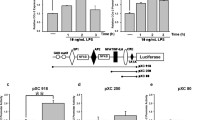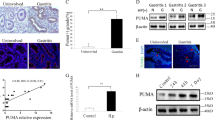Abstract
Peroxisome proliferator-activated receptor-γ (PPARγ), a member of the subfamily of ligand-dependent nuclear transcription factors, plays a key role in the regulation of the expression of genes associated with inflammation. In this study, using gastric mucosal cells in culture, we assess the role of PPARγ in the disturbances in gastric mucin synthesis and apoptotic processes evoked by Helicobacter pylori lipopolysaccharide (LPS). Exposure of gastric mucosal cells to the LPS led to a concentration-dependent decrease (up to 59.5%) in mucin synthesis, and this effect of the LPS was accompanied by a 6.5-fold increase in apoptosis, induction of COX-2 and NOS-2 protein expression, and the enhancement in PGE2 generation (18.6-fold) and NOS-2 activity (24.1-fold). However, the expression of COX-1 protein was not affected. Activation of PPARγ with a specific synthetic agonist, ciglitazone, countered (up to 90.2%) the LPS-induced reduction in mucin synthesis in a concentration-dependent manner, and this effect of the agent was reflected in a marked decrease in COX-2 and NOS-2 protein expression, reduction (up to 72.4%) in apoptosis and a decline (up to 84.1%) in PGE2 generation and NOS-2 activity (up to 90%). A pronounced prevention (88.2%) in the LPS-induced PGE2 release and the diminished COX-2 protein expression was also attained with the COX-2-selective inhibitor NS-398, but the effect was not associated with the impedance of the LPS inhibitory effect on mucin synthesis. Our findings thus demonstrate that the detrimental influence of H. pylori LPS on gastric mucin synthesis is closely linked to the increase in proapoptotic processes triggered by NOS-2 upregulation, and that PPARγ activation obviates this detrimental effect. Hence, pharmacological manipulation of PPARγ activation may provide therapeutic benefits in countering the disruptive effects of H. pylori on gastric mucosal mucus coat continuity.
Similar content being viewed by others
REFERENCES
Brzozowski, T., Konturek, P. C., Sliwowski, Z., et al. (1997). Lipopolysaccharide of Helicobacter pylori protects gastric mucosa via generation of nitric oxide, J. Physiol. Pharmacol. 48, 699–717.
Castrillo, A., de la Heras, B., Hortelano, S., et al. (2001). Inhibition of the nuclear factor кB (NF-кB) pathway by tetracyclic kaurene diterpenes in macrophages, J. Biol. Chem. 276, 15854–15860.
Ceruda-Morollon, E., Pieneda-Molina, E., Canada, F. J., et al. (2001). 15-Deoxy-Δ12,14-prostaglandin J2 inhibition of NF-кB-DNA binding through covalent modification of the p50 subunit, J. Biol. Chem. 276, 35530–35536.
Clancy, R., Varenika, B., Huang, W., et al. (2000). Nitric oxide synthase/ COX cross-talk: nitric oxide activates COX-1 but inhibits COX-2-derived prostaglandin production, J. Immunol. 165, 1582–1587.
Da Silva, J., Pierrat, B., Mary, J. L., et al. (1997). Blockade of p38 mitogen-activated protein kinase pathway inhibits inducible nitric oxide synthase expression in mouse astrocytes, J. Biol. Chem. 272, 28373–28380.
de Boer, W. A. (2000). Topics in Helicobacter pylori infection: focus on a ‘search-and-treat’ strategy for ulcer disease, Scand. J. Gastroenterol. 35 (Suppl. 232), 4–9.
DuBois, R. N., Abramson, S. B., Crofford, L., et al. (1998). Cyclooxygenase in biology and disease, FASEB J. 12, 1063–1073.
Forman, B. M., Chen, J. and Evans, R. M. (1997). Hypolipidemic drugs, polyunsaturated fatty acids, and eicosanoids are ligands for peroxisome proliferator-activated receptors α and δ, Proc. Natl. Acad. Sci. USA 94, 4312–4317.
Fu, S., Ramanujam, K. S., Wong, A., et al. (1999). Increased expression and cellular localization of inducible nitric oxide synthase and cyclooxygenase-2 in Helicobacter pylori gastritis, Gastroen-terology 116, 1319–1329.
Gorgoni, B., Caivano, M., Arzimendi, C., et al. (2001). The transcriptionalfactor C/EBPβ is essential for inducible expression of cox-2 gene in macrophages but not in fibroblasts, J. Biol. Chem. 276, 40769–40777.
Gupta, R. A., Polk, D. B., Krishna, U., et al. (2001). Activation of peroxisome proliferator-activated receptor γ suppresses nuclear factor kB-mediated apoptosis induced by Helicobacter pylori in gastric epithelial cells, J. Biol. Chem. 276, 31059–31066.
Hawkey, C. J. (2002). Cyclooxygenase inhibition: between the devil and the deep blue sea, Gut 50 (Suppl. 3), 25–30.
Hughes, F. J., Buttery, L. D. K., Hukkanen, M. V. J., et al. (1999). Cytokine-induced prostaglandin E2 synthesis and cyclooxygenase-2 activity are regulated both by a nitric oxide-dependent and-independent mechanism in rat osteoblasts in vitro, J. Biol. Chem. 274, 1776–1782.
Inoue, H., Tanabe, T. and Umesone, K. (2000). Feedback control of cyclooxygenase expression through PPARγ, J. Biol. Chem. 275, 28028–28032.
Jackson, L. M., Wu, K. C., Mahida, Y. R., et al. (2000). Cyclooxygenase (COX) 1 and 2 in normal, inflamed, and ulcerated human gastric mucosa, Gut 47, 762–770.
Kim, S. J., Ju, J. W., Oh, C. D., et al. (2002). ERK1/ 2 and p38 kinase oppositely regulate nitric oxide-induced apoptosis of chondrocytes in associationwith p53 and caspse-3, and differentiationstatus, J. Biol. Chem. 277, 1332–1339.
Laemmli, U. K. (1970). Cleavage of structural proteins during the assembly of the head of bacterio-phage T4, Nature 227, 680–685.
Laine, L. (2001). Approaches to nonsteroidal anti-inflammatory drug use in the high-risk patient, Gastroenterology 120, 594–606.
Liau, Y. H., Lopez, R. A., Slomiany, A., et al. (1992). Helicobacter pylori effect on the synthesis and secretion of sulfated gastric mucin, Biochem. Biophys. Res. Commun. 184, 1411–1417.
Marnett, L. J., Wright, T. L., Crews, B. C., et al. (2000). Regulation of prostaglandin biosynthesis by nitric oxide is revealed by target deletion of inducible nitric-oxide synthase, J. Biol. Chem. 275, 13427–13430.
Marshall, B. J. (1994). Helicobacter pylori, Am. J. Gastroenterol. 89, S116–S128.
Nakajima, A., Wada, K., Miki, H., et al. (2001). Endogenously PPARγ mediates anti-inflammatory activity in murine ischemia-reperfusioninjury, Gastroenterology 120, 460–469.
Piotrowski, J. (1998). Lipopolysaccharidea virulence factor of Helicobacter pylori: effect of antiulcer agents, J. Physiol. Pharmacol. 49, 3–24.
Piotrowski, J., Piotrowski, E., Skrodzka, D., et al. (1997). Induction of acute gastritis and epithelial apoptosis by Helicobacter pylori lipopolysaccharide, Scand. J. Gastroenterol. 32, 203–211.
Poligone, B. and Baldwin, A. S. (2001). Positive and negative regulation of NF-кB by COX-2, J. Biol. Chem. 276, 38658–38664.
Ratovitski, E. A., Bao, C., Quick, R. A., et al. (1999). An inducible nirtric-oxide synthase (NOS)-associated protein inhibits NOS dimerization and activity, J. Biol. Chem. 274, 30250–30257.
Romano, M., Ricci, V., Memoli, A., et al. (1998). Helicobacter pylori up-regulates cyclooxygenase-2 mRNA expression and prostaglandin E2 synthesis in MKN 28 gastric mucosal cells in vitro, J. Biol. Chem. 273, 28560–28563.
Sakamoto, J., Kimura, H., Moriyama, S., et al. (2000). Activation of human peroxisome proliferator-activated receptor (PPAR) Subtypes by pioglitazone, Biochem. Biophys. Res. Commun. 278, 704–711.
Shakibaei, M., Schulze-Tanzil, G., deSouza, P., et al. (2001). Inhibition of mitogen-activated protein kinase induced apoptosis of human chondrocytes, J. Biol. Chem. 276, 1389–1394.
Slomiany, B. L. and Slomiany, A. (1991). Role of mucus in gastric mucosal protection, J. Physiol. Pharmacol. 42, 147–161.
Slomiany, B. L. and Slomiany, A. (2001). Blockade of p38 mitogen-activatedprotein kinase pathway inhibits inducible nitric oxide synthase and gastric mucosal inflammatory reaction to Helicobacter pylori lipopolysaccharide, Inflammopharmacology 8, 371–382.
Slomiany, B. L. and Slomiany, A. (2002). Suppression of gastric mucosal inflammatory responses to Helicobacter pylori lipopolysaccharideby peroxisome proliferator-activatedreceptor γ activation, IUBMB Life 53, 303–308.
Slomiany, B. L., Liau, H., Lopez, R. A., et al. (1993). Nitecapone effect on the synthesis and secretion of gastric sulfomucin, Gen. Pharmacol. 24, 69–73.
Slomiany, B. L., Murty, V. L. N., Piotrowski, E., et al. (1994). Activation of arachidonly phospholipase A2 in prostaglandin-mediatedaction of sucralfate, Gen. Pharmacol. 25, 261–266.
Slomiany, B. L., Piotrowski, J. and Slomiany, A. (1997). Anti-Helicobacter pylori activities of ebrotidine, Arzneim. Forsch.-Drug Res. 47, 475–482.
Tanaka, T., Kohno, H., Yoshitani, S., et al. (2001). Ligands for peroxisome proliferator-activated receptors α and γ inhibit chemically induced colitis and formation of aberrant crypt foci in rats, Cancer Res. 61, 2424–2428.
Warner, T. D., Giuliano, F., Vojnovic, I., et al. (1999). Nonsteroid drug selectivities for cyclo-oxygenase-1 rather that cyclo-oxygenase-2 are associated with human gastrointestinal toxicity: a full in vitro analysis, Proc. Natl. Acad. Sci. USA 96, 7563–7568.
Wilson, K. T., Fu, S., Ramanujam, K. S. and Meltzer, S. J. (1998). Increased expression of inducible nitric oxide synthase and cyclooxygenase-2 in Barrett's esophagus and associated adenocarcinomas, Cancer Res. 58, 2929–2934.
Xin, X., Yang, S., Kowalski, J., et al. (1999). Peroxisome proliferator-activatedreceptor γ ligands are potent inhibitors of angiogenesis in vitro and in vivo, J. Biol. Chem. 274, 9116–9121.
Yu, S., Cao, W. Q., Kashireddy, P., et al. (2001). Human peroxisome proliferator-activatedreceptor α.PPARα) supports the induction of peroxisome proliferation in PPARα-deficient mouse liver, J. Biol. Chem. 276, 42485–42491.
Author information
Authors and Affiliations
Rights and permissions
About this article
Cite this article
Slomiany, B.L., Slomiany, A. Peroxisome proliferator-activated receptor γ activation counters the detrimental effect of Helicobacter pylori lipopolysaccharide on gastric mucin synthesis. Inflammopharmacology 11, 223–236 (2003). https://doi.org/10.1163/156856003322315578
Issue Date:
DOI: https://doi.org/10.1163/156856003322315578




